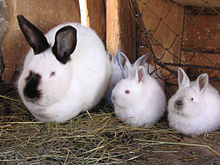Californians
The Californian is a medium-sized breed of rabbit .
Appearance of the Californian rabbit
The Californian rabbit was bred to be a farm rabbit where appearance was secondary. It resembles the type with the blocky body, the relatively short fleshy ears and strong limbs of the New Zealand white rabbit , which was also used in the outbringing of the breed. In terms of color, the Californian corresponds to the Russian rabbit , which was also involved in the creation of the Californian. Accordingly, the Californian has a pure white fur, red eyes and colored ears, legs, mustache (mask) and flower. The Californian rabbit is recognized in the colors black, blue and brown. The original, black color is the most common. The corresponding hereditary formulas are:
- Black: anBCDg (German symbols) or aBchDE (English symbols)
- Havana-colored (brown): anBcDG (German symbols) or aBchdE (English symbols)
- Blue: anBCdg (German symbols) or abchDE (English symbols)
The drawing is determined by the Russian factor, therefore the animals are born pure white and show the phenomenon of cold blackening . Due to the more compact shape, Californians usually show a more blurred drawing than Russian rabbits. The Californian rabbit is said to have a weight of 4 to 5 kg; Animals weighing less than 3.5 kg and more than 5 kg are excluded from the evaluation at pedigree rabbit shows.
History of the Californian Rabbit
The Californian rabbit is named after its country of origin, the US state of California , where it was bred from Russian rabbits , New Zealanders and Great Chinchilla rabbits in the 1920s. George S. West is specified as the breeder. The aim of breeding was a typical farm rabbit with a good meat set, fine bone structure, rapid growth and a thick, as white as possible fur. The greater chinchilla rabbit was crossed in order to achieve the desired thick and soft fur. In 1928 the first animals with a drawing resembling the Russian rabbit and a weight of about 4 kg are said to have been reached. The breed has been recognized in the US since 1939, imported to Great Britain in 1947 and to mainland Europe in the mid-1960s. The breed has been recognized in Germany since 1968 and in the Netherlands since 1966.
Californians today
Californians are a relatively rare breed of rabbit. Presumably due to the greater weight and the more compact shape, the typical drawing is much less clean than that of the Russian rabbit. Well-colored Californian rabbits usually do not show the required type and have difficulty reaching full weight and vice versa.
Similar races
The Russian rabbit of the German breed rabbit standard is significantly smaller (weight around 2.25 kg) and slimmer than the Californian rabbit.
The European standard knows a large Russian rabbit with the same weight requirement, which looks a bit slimmer overall and corresponds in type to the Russian rabbit.
In the "Assessment Regulations for Pedigree Rabbits in Socialist Countries", which also applied in the GDR from 1980 until reunification , the Nitran rabbit was recognized, a Czech breed, a medium-sized rabbit with blue markings that is still bred in the Czech Republic today .
The Zobor rabbit was recognized as a new Slovak breed in 2004 . This rabbit corresponds in shape and type to the Californian, but only shows the Russian badge on ears, flower and parts of the hind legs, i.e. H. In contrast to the Californian, it has no mask and white forelegs. With an ideal weight of 4.25 to 5.25 kg (Slovak standard), it is slightly larger than the Californian. The breed originated from crossing the Nitran rabbit with White New Zealanders . The drawing comes from the combination of the Russian factor (agromelanie) with the Dutch piebald , which, covered by albinism , must have been present in the White New Zealanders used for crossing . The cold blackening in young animals leads to an appearance in the form of the Dutch drawing in the Zobor rabbit.
The Zobor rabbit is permitted in Slovakia in the colors black, Havana and blue.
Californian rabbits of the type and color are bred for meat production all over the world without any particular breed characteristics being considered.
Web links
literature
- Wolfgang Schlolaut: The big book of the rabbit , 2nd edition, DLG , Frankfurt am Main 1998, ISBN 3-7690-0554-6 .
- John C. Sandford: The domestic rabbit . 5th edition, Blackwell Science, Oxford 1996, ISBN 0-632-03894-2 (English).
- Standard van de Konijnenrassen, Cavia´s en kleine Knaagdieren, Nederlandse Konijnenfokkersbond, Venlo, 1990.
- J. Broekhuis, DWH Krooshof: Rasbeschrijfing van de Rus, Californian, Nieuwzeelander, Nederlandse Russen . Californian & Witte Nieuwzeelander Club, 1996.
- H. Majaura: Californian rabbits - In the conflict of beauty and performance . in: Rabbit Newspaper , 12/2006, pp. 4-7, ISSN 1613-6357 .
- J. Rafay: Zoborkaninchen - New breed in the Slovak Breeding Association , in: Rabbit newspaper , 10/2006, p. 16, ISSN 1613-6357 .

